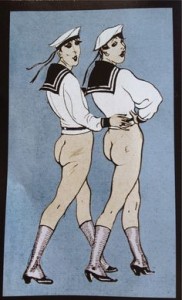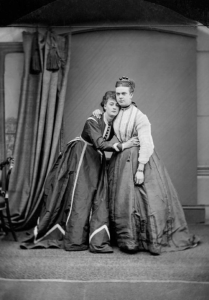A Look at Rentboys Through History
 A Look at Rentboys Through History
A Look at Rentboys Through History
Written for brainiacs, but also fascinating to laypeople, Male Sex Work and Society (Harrington Park Press), edited by Victor Minichiello and John Scott,is a collection of revealing essays and studies that explores male sex work from a rich array of perspectives and disciplines.
Leading contributors from around the world examine the field both historically and cross-culturally from fields including public health, sociology, psychology, social services, history, filmography, economics, mental health, criminal justice, geography, migration studies, and more.
Yup, the book is for smart folks and sexuality students, but it’s also for those of us in the LGBT – particularly gay male – community, where we’re well aware (and perhaps more accepting) of the male sex worker, from cash friendly go-go boys to discreet online entrepreneurs to Rentboy.com’s Hookie Award trophy-wielding escorts.
Beautifully designed and filled with surprising statistics, historic photos, and artfully shot man-candy, Male Sex Work and Society is an interesting, insightful, and enlightening read. Below is a selection of facts about the men working in the world’s oldest profession, culled from the book’s first chapter, “Male Sex Work in Sociohistoric Context”:
- In fifth-century BC Athens and first-century AD Rome, male prostitutes were typically noncitizens: foreigners and slaves. An Athenian man could choose to be a prostitute, but in doing so he forfeited his civil rights. Prostitutes were not only taxed and registered in the city’s prostitute logbook but also protected by law–though at the same time scorned and taunted as sluts. Rome had a national holiday celebrating male sex workers.
- Roman Emperors Caesar and Nero were bottoms. For rich and titled Roman men, it was culturally acceptable to keep a “concubinus”–a slave to service them sexually before marriage.
- In 390 AD, following an edict issued by Emperor Theodosius, male brothels in Rome were raided and prostitutes were burnt alive in the streets as throngs of onlookers cheered.
- In fifteenth-century Florence, it was not uncommon for young men (12 to 20 years old) to engage in long-term sexual relationships with rich benefactors, many of whom were surprisingly young, often in their 20s. And the parents approved!
- In mid-1600s Japan, “kabuki wakashu” male actors were often prostitutes, much sought after by male and female patrons for their beauty. It was common for Buddhist and samurai warriors to have sex with their young male apprentices, in much the same way that Greek noblemen were permitted to have a sex with the youths they were mentoring–as long as the relationship was educational, not purely sexual.

- Under dire conditions in 1607 Jamestown, Virginia, sailors from British ships sold biscuits known as hardtack (made from flour, water, and sometimes salt) to starving local men in exchange for sex (among other things).
- In 1677 a wealthy gentleman was busted for trying to bribe two indentured male servants to drop their pants in exchange for a bushel of corn and gunpowder. Due to his status, he was not sentenced. However, his estate was held in escrow until his death.
- Beginning in the early nineteenth century, it was common for British soldiers to supplement their meager pay by hustling, often earning as much as a week’s pay in half an hour. In addition to being attractive to those seeking straight trade, soldiers were thought to be trustworthier and less likely to blackmail their clients than typical street hustlers.
- The tradition of soldiers selling sex to gay clients dates back to the early 1700s and continued well into the twentieth century. In “barracks prostitution,” hustling soldiers frequented their own bars, worked “soldiers’ promenades,” and regularly initiated new recruits into hustling.
- In Queen Victoria’s London, hustlers were found in Piccadilly Circus, where men advertised their services by fingering their lapels. In earlier days, male prostitutes were often bottoms to customer tops. In the mid-to-late 1800s, the positions were flipped, with the working-class men generally topping their upper-class customers.
- Oscar Wilde referred to sex with the young working-class male prostitutes (ages 16 – 20) he favored as “feasting with panthers” because “their passion was all body and no soul.”
- Thanks to a three-year gonorrhea outbreak in the early 1880s at a reform school near Baltimore, it was discovered that the boys were trading sex for tobacco, candy, and other luxuries.

Infamous 19th-century cross-dressing male sex workers, Ernest Boulton and Frederick William Park, aka “Stella” Boulton and “Franny” Park. (Male Sex Work and Society)
- Popular in America and Europe at the turn of the nineteenth century were transvestite male hustlers known as “fairies.” Some worked in all-fairy brothels and saloons, others worked in female brothels as exotic offerings for male clients, and still others worked the streets, either on their own strolls or on strips known to have a mixed menu of hustlers on display.
- In the late 1800s, London’s Cleveland Street Affair exposed a male prostitution ring run by young teenage messenger boys from the Royal Post Office. None were charged in the bust, as the court decided the boys were too young to know better.
- In 1899 New York City, hustler bars proliferated on the Bowery near Fifth Street (Little Bucks, Columbia Hall), Bleecker Street (The Slide), and West Third Street (The Golden Rule Pleasure Club, favored by transvestite hustlers).
- During the Depression, around 1932, so many men took to prostitution that the “straight-acting” hustler became the new norm on more popular strolls (also walked by down-and-out soldiers), pushing out the effeminate streetwalkers known as “fairies”.
- As homosexuals became more visible and identifiable due to gay liberation, straight or straight-acting hustlers began to fear selling sex to other men, because by doing so they’d be identified as a homosexual. Not only did they reject “self-identifying” as gay, but even gay hustlers knew they could not identify as such without turning off their gay clientele, who far preferred straight trade. The upside was that with gay liberation, gay men began buying sex from other gay men instead of straight hustlers who recoiled at the thought of being identified as gay.
And that’s just the first chapter. Additional chapters in this encyclopedic 512-page book cover a variety of topics from male sex work in film (from “Sunset Boulevard” to “Private Idaho”), to marketing, clients, laws and regulations, mental health, public health and HIV, social services, and male sex work in Africa, China, Russia, Latin America, and Europe. Male Sex Work in Society explores these issues and many more, offering the most comprehensive overview to date of the important research done on this topic.
Male Sex Work and Society, Edited by Victor Minichiello and John Scott. Available now

